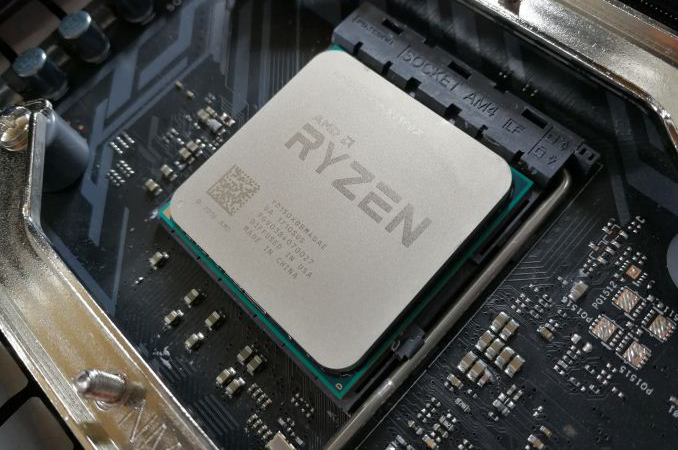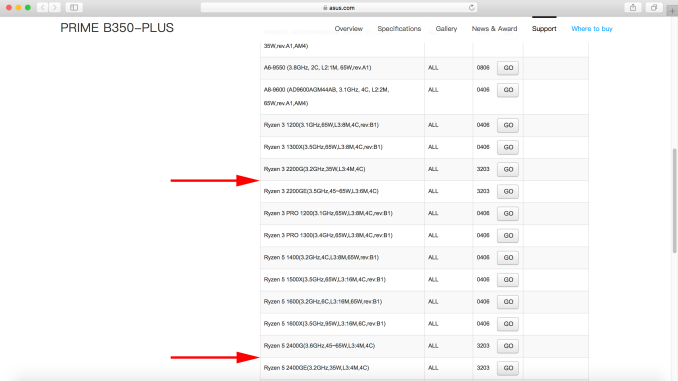AMD Readies Ryzen 3 2200GE & Ryzen 5 2400GE APUs with Reduced TDP
by Anton Shilov on February 12, 2018 2:00 PM EST
AMD is preparing to release low-power versions of its Ryzen APUs with built-in Radeon Vega graphics. The new Ryzen 3 2200GE and Ryzen 5 2400GE chips will have a 35 W TDP and will operate at lower frequencies when compared to the Ryzen 3 2200G and the Ryzen 5 2400G that hit the market this week. ASUS has already added support for the new energy-efficient APUs to BIOS of one of its AM4 motherboards, so the actual launch is imminent.
AMD’s Ryzen 3 2200G with Radeon Vega 8 graphics as well as Ryzen 5 2400G with Radeon RX Vega 11 graphics have configurable TDP of 45 - 65 W and enable AMD to compete for mainstream desktops. This market is rather big and it is important to address it with competitive offerings, but sales of traditional desktops are stagnating at best. Meanwhile, demand for small form-factor desktops is growing, so AMD has to offer processors with reduced power consumption to address them. The company already has multiple energy-efficient Excavator-based APU for the AM4 platform in its arsenal and in the coming weeks or months it will release Zen-based APUs for SFF desktops.
Initially, AMD plans to offer two energy-efficient Zen-based APUs: the Ryzen 3 2200GE and the Ryzen 5 2400GE. Both APUs feature four Zen cores as well as Radeon Vega graphics, but their exact specs and configs are yet to be disclosed. According to ASUS, the Ryzen 5 2400GE will feature four cores with SMT operating at 3.2 GHz (down from 3.6 GHz of the Ryzen 5 2400G) as well as a 35 W TDP. Meanwhile, the Ryzen 3 2200GE appears to feature four cores without SMT working at 3.2 GHz (down from 3.5 GHz of the 2200G) along with a 35 W TDP*. It remains to be seen whether AMD’s Ryzen 3 2200GE and Ryzen 5 2400GE sustain iGPU configurations of their higher-power brethren (obviously, at reduced clocks) as well as DDR4-2933 support, but at this point base CPU frequencies is all we know about these products.
| AMD Ryzen 2000-Series APUs | ||||
| Ryzen 5 2400G with Vega 11 |
Ryzen 5 2400GE with Vega 11 |
Ryzen 3 2200G with Vega 8 |
Ryzen 3 2200GE with Vega 8 |
|
| CPU Cores/Threads | 4 / 8 | 4 / 4 | ||
| Base CPU Frequency | 3.6 GHz | 3.2 GHz | 3.5 GHz | 3.2 GHz (?) |
| Turbo CPU Frequency | 3.9 GHz | ? | 3.7 GHz | ? |
| TDP @ Base Frequency | 65 W | 35 W | 65 W | 35 W |
| Configurable TDP | 46-65 W | 35 W | 46-65 W | 35 W |
| L2 Cache | 512 KB/core | |||
| L3 Cache | 4 MB | |||
| Graphics | Vega 11 | Vega 11 (?) | Vega 8 | Vega 8 (?) |
| Compute Units | 11 CUs | 11 CUs (?) | 8 CUs | 8 CU (?) |
| Streaming Processors | 704 SPs | 704 SPs (?) | 512 SPs | 512 (?) |
| Base GPU Frequency | 1250 MHz | ? | 1100 MHz | ? |
| DRAM Support | DDR4-2933 Dual Channel |
DDR4 Dual Channel |
DDR4-2933 Dual Channel |
DDR4 Dual Channel |
| OPN PIB | YD2400C4FBBOX | ? | YD2200C5FBBOX | ? |
| OPN Tray | YD2400C5M4MFB | ? | YD2200C4M4MFB | ? |
| Price | $169 | ? | $99 | ? |
| Bundled Cooler | AMD Wraith Stealth | ? | AMD Wraith Stealth | ? |
The 35W Ryzen APUs will enable AMD to compete for OEM SFF and ultra-slim Mini-ITX DIY builds (previous-gen Bristol Ridge chips were hardly attractive for enthusiasts), which will help the company to further increase its market share.
AMD did not comment on the news story because the Ryzen 3 2200GE and the Ryzen 5 2400GE have not been announced, so we cannot fill the gaps when it comes to specs and prices of the new APUs.
*Specifications of the Ryzen 3 2200GE are a bit less clear from the ASUS listings because the company attributes partially correct specs of the Ryzen 3 2200G (the L3 cache size the company cites is incorrect) to the 2200GE (see the image below). Now, if the company attributes specs of the 2200GE to the 2200G, then we have basic specifications of the former, but if there is a mistake somewhere, we do not and the 3.2 GHz base frequency figure is inaccurate.
Related Reading:
Source: ASUS











25 Comments
View All Comments
jjj - Monday, February 12, 2018 - link
You keep claiming that SFF is doing great, likely because some Intel PR troll made that claim but you have never backed that claim with data.How about you define what it means in units or % of the desktop market, just to be sure you aren't spreading fake news.
Hurr Durr - Monday, February 12, 2018 - link
AMD zombie buttpain is delicious.ganeshts - Monday, February 12, 2018 - link
See it this way : If SFF was not doing great - why would every PC vendor out there come out with a SFF PC - and, in the case of someone like GIGABYTE - literally 20 different variations of the BRIX targeting different market segments?kgardas - Monday, February 12, 2018 - link
Because of a need to research draining options in overall shrinking market.ganeshts - Monday, February 12, 2018 - link
That would make sense for one generation - not generation after generation.lilmoe - Monday, February 12, 2018 - link
^ThisRemember Chromebooks and Android tablets?
niva - Monday, February 12, 2018 - link
Chromebooks and Android tablets are still around, but the reason they did not succeed has more to do with the implementations of vendors (terrible uninspiring hardware, butchering Android/Chrome OS, failing to provide updates). It's a completely different situation than SFF. I too question how well SFF is doing. My original Phenom 1 system continues to work fine for me and I've not had the need for another HTPC. At some point I'll need another machine for a build and while the SFFs look cool, I'm not sure I'll be ready to give up the big case that can store all sorts of hard drives, etc.lilmoe - Monday, February 12, 2018 - link
"but the reason they did not succeed has more to do with the implementations of vendors (terrible uninspiring hardware, butchering Android/Chrome OS, failing to provide updates)"The same could be said about SFF. Pricing is a joke. You DON'T sell a SFF machine for double the price of a Playstation 4..... BARE BONES. THAT's the market you're targeting.
Sure, SFF might become more appealing with AMD's new offerings. We'll have to see the value proposition first.
bill.rookard - Tuesday, February 13, 2018 - link
But - they're not double the price. I just picked up one of the Apollo Lake based NUCs for $120, 2 sticks of DDR3L for $50, and put in one of my 128GB SSDs that I had lying around - even new, that would have cost another $75.00. Net result is a perfectly capable HTPC for around $240ish. That's not double.Of course if you go with i3/i5/i7 CPUs instead of the quad core Celeron J3455 you'll pay more. But - for HTPC use, it's perfectly adequate. Kodi runs at 10% usage playing back my videos (720p MKV) which leaves it plenty of headroom.
bull2760 - Wednesday, February 14, 2018 - link
Yeah they are a huge success in the Education sector. Kicked Apple and MS out the door. Chomebooks and growing year after year. Lets schools achieve 1 to1 at a low cost.